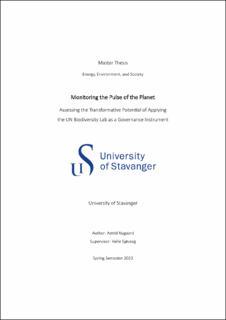| dc.description.abstract | The current degraded state of nature proves that global efforts to reverse the loss of biodiversity has not yet been sufficient. However, in December 2022, a significant milestone was achieved as the international community reached a consensus on the Kunming-Montreal Post-2020 Global Biodiversity Framework. The vision of this framework is for humanity to live in harmony in nature by 2050, and reaching this vision will require profound societal changes. This thesis aims at examining how the implementation of a Big Earth Data platform in the decision- and policy-making process can facilitate such transformative changes. This is explored through a case study of the UN Biodiversity Lab, a platform that explicitly aims at supporting national stakeholders deliver on the Global Biodiversity Framework.
To examine the platform, a walkthrough- and content analysis method has been applied. The results from these methods are presented and analysed through a Big Earth Data Platform framework, which aims at providing frames for how a Big Earth Data platform should optimally be designed to support sustainability. The analysis shows that the UN Biodiversity Lab to a large extent is designed in accordance with this framework, as it is embedded in society, promotes actionable intelligence, and is listed as a digital public good. Thus, the platform seems to have a large potential to provide decision-makers, practitioners, and the public access to the best available data, information, and knowledge on biodiversity matters.
The thesis contributes to theory on transformative biodiversity governance by examining the transformative potential of one specific governance instrument. Findings show that the UN Biodiversity Lab can support integrative, inclusive, adaptive, transdisciplinary, and anticipatory governance in conjunction. The platform can potentially also influence the indirect drivers of biodiversity loss through strengthening monitoring mechanisms, increasing awareness, and supporting polycentric governance. This implies that despite the indirect drivers not easily being quantified as spatial data, the platform can still target the indirect drivers of biodiversity loss by influencing key leverage points in society. The study therefore concludes that applying a Big Earth Data platform in the decision-making process can be an important tool for reaching the vision of the Global Biodiversity Framework. There are however some key challenges that must be tackled to unlock the potential of the technology. This includes solving technical issues, securing adequate funding, enabling co-production of knowledge, and establishing consistent reporting practices. | |
